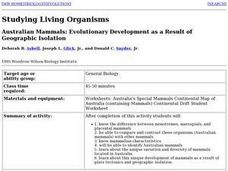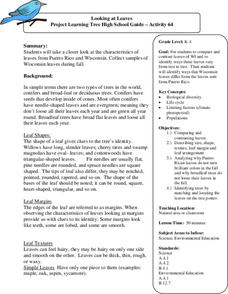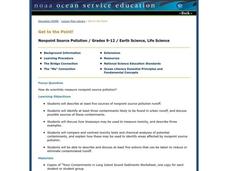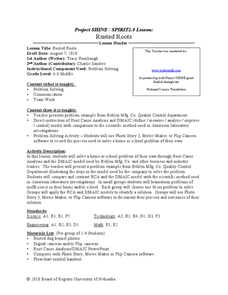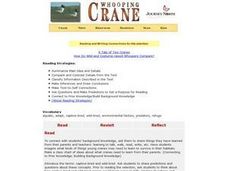Curated OER
Sonar Simulation
Students explore how a side-scan sonar can help locate underwater objects. In this hands- on lesson students compare side-scan sonar and other methods used to search for underwater objects by creating their own "simulation" of a...
Curated OER
The Invisible Zoo
Students differentiate cold and warm-blooded animals using infrared images. In this physics instructional activity, students compare the images formed by infrared and visible light. They explain how scientists use infrared technology to...
Curated OER
Australian Mammals: Evolultionary Development as a Result of Geographic Isolation
Students examine the differences between monotremes, marsupials, and placental mammals and are able to contrast these organisms with other mammals. They learn about unique variation and the diversity of mammals located in Australia.
Curated OER
Now Hear This!
Students observe the differences between low- and high-frequency sounds. They research and compare the characteristics of various animals that rely on infrasonic sounds to communicate.
Curated OER
What Becomes of Cell?
Sixth graders analyze and compare a cell's tissues, organs and organ systems. They watch a video reviewing the body systems and design poster boards showing their functions.
Project SMART
Dinosaur Trek
Second graders investigate dinosaurs. They explore various websites, submit questions to a paleontologist online, construct cut and paste model dinosaur skeletons, develop a graph to compare dinosaurs, and label pictures from online...
Curated OER
Looking At Leaves
Students investigate the different leaves of Wisconsin. They gather samples of leaves in order to compare to the samples taken from Puerto Rico. They make observations and collect data recording the size, shape, and texture of the...
Curated OER
Ecosystem Damage from Household Cleaners
Third graders assess the damage done to various ecosystems by cleaning products and discover how scientists test water quality. Using stream water and common household cleaning agents, they work in groups to test for pH levels. Once...
Curated OER
Volcano!-Thar She Blows!
Middle schoolers describe how volcanoes are formed. They name the types of boundaries where volcanoes occur. They utilize models to illustrate the occurence of volcanoes and earthquakes along plate boundaries. They compare and constrast...
Curated OER
Corrosion/Conservation/Preservation
Students examine the reasons why metal corrodes in regard to metal artifacts. In groups, they discover the affects of salt water on metal and compare the type of corrosion found on iron. They also research the types of metal...
Curated OER
What Do Fossils Tell About the Past?
In this fossils worksheet, students compare characteristics of fossils with living organisms currently found on the earth. This worksheet is a graphic organizer.
Curated OER
Bacteria
In this bacteria worksheet, students compare archaebacteria and eubacteria and describe factors that identify prokaryotes. This worksheet has 4 matching and 6 short answer questions.
Curated OER
Is there a Doctor in the Treehouse?
Students investigate the afflictions of trees and compare the health of a human to that tree. In this tree activity students complete an activity and create and present a report.
Curated OER
Get to the Point!
High schoolers write out sources of pollution and identify contaminants are most likely found in urban runoff. In this pollution lesson students compare toxicity tests and chemical analysis of potential contaminants.
Curated OER
It's Not Your Fault
Students study the San Andreas Fault, calculate its movements, and compare the movements on both sides. In this earthquake lesson students use the Internet to track movement, and calculate movement using a spreadsheet.
Curated OER
The Big Blow
High schoolers identify and explain factors that contribute to extreme storms in the Great Lakes. In this investigative lesson plan students study the weather systems in the Great Lakes and compare cyclones to tropical storms.
Curated OER
Straw Rockets in Flight! Engineer's Delight
Sixth graders study air compression and how it can power a rocket. In this creative lesson students work with a partner and build a rocket then compare air compressions and graph their results.
Curated OER
Rusted Roots
Students create a flowchart on the root cause method. In this inquiry lesson plan, students compare RCA and the DMAIC model with the scientific method of problem solving. They investigate a problem in school and present their findings in...
Curated OER
Frog Or Toad?
In this expository comprehension worksheet, students read a 1-page informational article about frogs and toads, answer short answer questions, and fill out a Venn diagram to compare the two amphibians.
Curated OER
A Tale of Two Cranes How Do Wild and Costume-raised Whoopers Compare?
Students explore what young cranes need to do to survive.
Curated OER
Land Use Change Over Time
Young scholars use historical aerial photographs and current aerial photographs to compare the change over time to the land. In this land changing lesson plan, students analyze, compare, contrast, and list the land change in their own...
Curated OER
How Hot Is Hot In Namib?
Students research and demonstrate the temperatures of the Namibian Desert. They watch and discuss a video, conduct an experiment to demonstrate the desert temperatures, record their results in the form of a graph, and compare/contrast...
Curated OER
Balloon Rockets
Learners, after reviewing and analyzing Newton's third law of motion, make balloon rockets and experiment with a variety of models. After the experiment, they chart the results and form conclusions. In addition, they compare/contrast...
Curated OER
Scientific Method
Learners conduct an experiment and complete a chart demonstrating some of the basic properties and components of water via the scientific method. They encompass strategies such as questioning, making predictions, comparing/contrasting...
Other popular searches
- Reading Compare and Contrast
- Compare and Contrast Essay
- Compare & Contrast Essays
- Compare and Contrast Writing
- Compare and Contrast Lesson
- Compare and Contrast Themes
- Compare Contrast Myth Fable
- Compare Contrast Essay
- Compare Contrast Paragraphs
- Compare and Contrast Math
- Compare and Contrast Setting
- Christmas Compare Contrast




